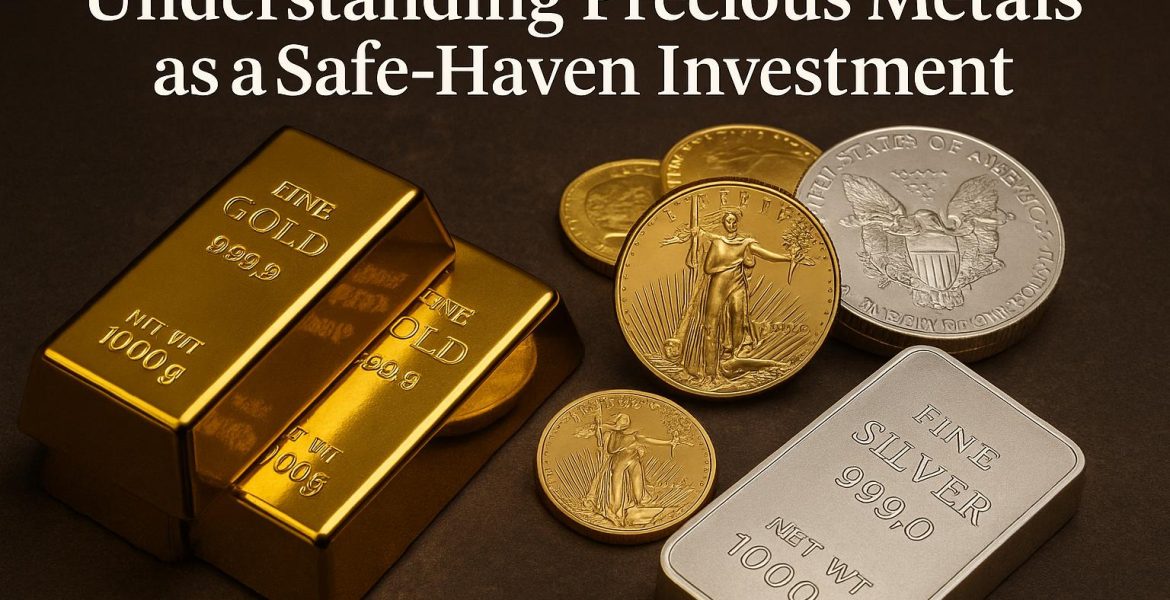
Understanding Precious Metals as a Safe-Haven Investment
admin - October 25, 2025Introduction to Precious Metals as Safe-Haven Investments
Precious metals, such as gold, silver, platinum, and palladium, have long been regarded as reliable investments, particularly during periods of economic uncertainty. These metals serve as a hedge against inflation and currency fluctuations, making them attractive to investors seeking stability. This article explores the role of precious metals in investment portfolios, their historical significance, and how they compare to other assets. By doing so, it provides a comprehensive understanding of why they are considered safe havens by many investors worldwide. For anyone keen on expanding their knowledge about investment strategies, an exploration of precious metals is essential.
Why Precious Metals Are Considered Safe Havens
The concept of a safe-haven investment refers to an asset that retains or increases its value during times of market volatility. Precious metals meet this criterion due to several factors.
Intrinsic Value: Unlike paper currencies, precious metals have intrinsic value derived from their rarity and industrial use. This intrinsic value provides a cushion against inflation and economic downturns. When inflation occurs, the value of money tends to decrease, thus reducing purchasing power. However, because precious metals are tangible assets with intrinsic worth, they often maintain their value better during inflationary periods.
Limited Supply: The supply of precious metals is relatively fixed, as they are naturally occurring and cannot be produced endlessly like fiat currency. This scarcity often contributes to their value. When demand for these metals increases, their limited supply ensures that their prices generally increase, making them a reliable investment option.
Global Acceptance: Precious metals are universally recognized and traded across the globe, enhancing their liquidity and attractiveness as investment options. This global recognition means that investors can buy or sell precious metals virtually anywhere, providing a level of liquidity that many other assets do not offer.
Historical Perspective
Throughout history, precious metals have played a pivotal role in shaping economies. Gold, in particular, has been used as currency and a store of value for millennia. Its significance during periods of uncertainty, such as wars and financial crises, has reinforced its status as a reliable investment. For instance, during times of war, when traditional currencies may become devalued, precious metals remain a stable asset. Even today, central banks hold gold reserves as a safeguard against economic instability, underscoring their enduring trust in its value.
Historically, gold and silver served as the foundation of the monetary system. Until the 20th century, many countries operated under a gold standard, where the value of their currency was directly linked to a specified amount of gold. Although most nations have moved away from the gold standard, its presence in the global financial system remains significant. This historical perspective highlights the durability and credibility of precious metals as investment options.
Comparing Precious Metals to Other Investments
When evaluating precious metals against other investment options, several factors come into play.
Volatility: Although precious metals are generally less volatile than stocks, they are not immune to price fluctuations. Investors should be aware of market trends and geopolitical factors that influence price movements. Over the years, precious metals have exhibited periods of price spikes and slumps, influenced by various factors like changes in central bank policies, geopolitical tensions, and shifts in supply and demand dynamics.
Dividend Yield: Precious metals do not yield dividends or interest, unlike bonds or dividend-paying stocks. Investors should weigh the benefits of capital preservation against potential income from other investments. For those seeking income-generating investments, stocks or bonds might be preferable. However, for those prioritizing stability and preservation, precious metals can serve as a solid foundation in a diversified portfolio.
Portfolio Diversification: Precious metals can enhance a portfolio’s diversification, reducing overall risk. By maintaining a mix of various asset classes, investors can mitigate losses during market downturns. Including precious metals in a portfolio means that in times of financial stress or currency depreciation, the overall portfolio impact can be cushioned, as these metals often move inversely to other assets like equities.
The Role of Technology in Precious Metals Investment
With advancements in technology, accessing precious metals markets has become more straightforward. Online platforms allow investors to buy, sell, and trade metals with ease. Additionally, innovation in financial instruments, such as exchange-traded funds (ETFs), offers exposure to precious metals without physical ownership. ETFs related to precious metals can be particularly attractive for those who want to invest without the logistical challenges of storing physical metals.
Moreover, technology has played a pivotal role in democratizing access to precious metals. Online advisors and investment platforms provide investors with detailed insights, analytics, and forecasts, equipping them with the necessary tools to make informed investment decisions. This technological transformation has bridged the gap between amateur and professional investors, making precious metals a more accessible investment avenue for all.
Conclusion
Investing in precious metals as a safe-haven strategy offers potential benefits, including protection against inflation and diversification. However, it is crucial for investors to conduct thorough research and consider their financial goals before incorporating these assets into their portfolios. As with any investment, understanding the risks and rewards is essential for making informed decisions. Different metals serve different investment purposes, and understanding these nuances ensures that investors select the most appropriate products for their specific needs.
For more detailed insights on investment strategies, consider consulting professional financial advisors or exploring resources from credible financial websites. Also, understanding the geopolitical and economic indicators that may influence precious metals can equip investors with the foresight needed to navigate this market effectively. Navigating the precious metals market requires a blend of historical knowledge, market insight, and innovative strategies. By leveraging these factors, investors can harness the true potential of precious metals, leading to a balanced and robust investment portfolio.
This article was last updated on: October 25, 2025
